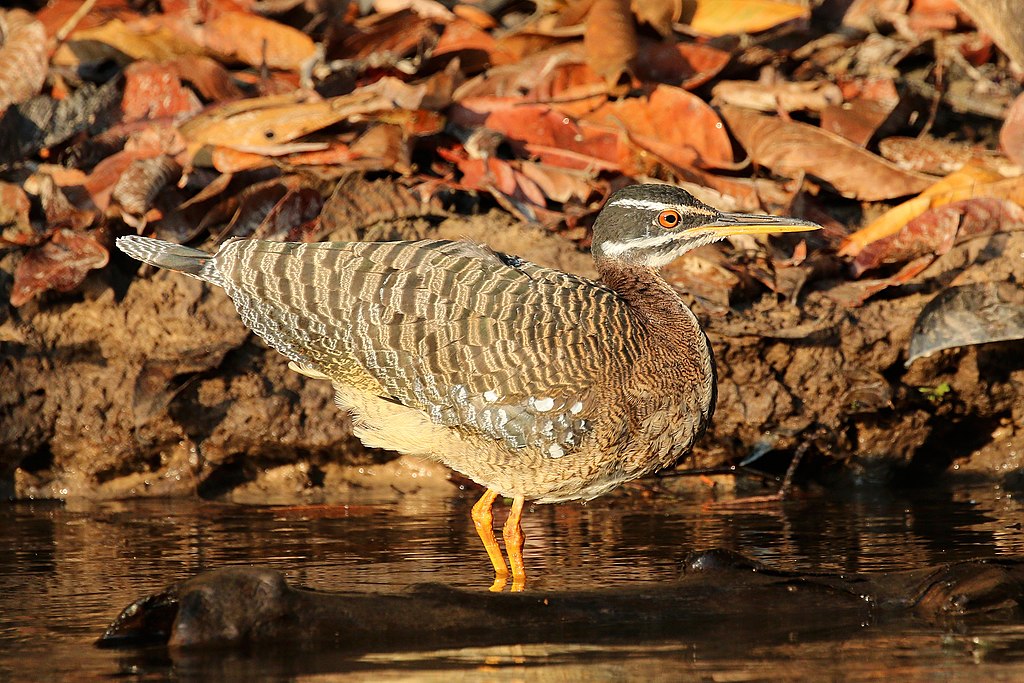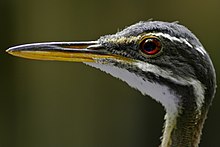
Taxonomy
The sunbittern is usually placed in the Gruiformes, but this was always considered preliminary. Altogether, the bird is most similar to another bird that was provisionally placed in the Gruiformes, the kagu (Rhynochetos jubatus).[4][5] Molecular studies seem to confirm that the kagu and sunbittern are each other's closest living relatives and have a similar wing display.[6][7] They are probably not Gruiformes (though the proposed Metaves are just as weakly supported).[8] Altogether, the two species seem to form a minor Gondwanan lineage which could also include the extinct adzebills and/or the mesites, and is of unclear relation to the Gruiformes proper. Notably, the kagu and mesites also have powder down.Subspecies
The sunbittern was formerly treated as two species (E. helias and E. major), but now they are treated as a single species with considerable variation between the subspecies. The three subspecies are recognised on the basis of plumage characters and size. The three subspecies are allopatric.[3]- E. h. helias (Pallas, 1781) – Amazonian sunbittern
- E. h. major Hartlaub, 1844 – northern sunbittern
- E. h. meridionalis Berlepsch & Stolzmann, 1902 – foothill sunbittern
Description
Head
The sunbittern has a long and pointed bill that is black above, and a short hallux as in shorebirds and rails. In the South American subspecies found in lowlands east of the Andes, the upperparts are mainly brown, and the legs and lower mandible are orange-yellow. The two other subspecies are greyer above, and their legs and bill are sometimes redder.[3]
Distribution and habitat
The sunbittern's range extends from Guatemala to Brazil. The nominate race, E. h. helias, is found east of the Andes in lowland tropical South America, from the Orinoco basin, through the Amazon basin and Pantanal. The subspecies E. h. meridionalis, has a more restricted distribution, being found along the East Andean slope in south-central Peru, in the lower subtropical zone at altitudes of 800–1,830 m (2,620–6,000 ft). The final subspecies, E. h. major, is found at various altitudes ranging from southern Guatemala, through Central America and the Chocó to western Ecuador.[3] This subspecies may also be present in southern Mexico. It has been traditionally reported from the Atlantic slope of Chiapas, but no specimens are known and there have been no recent records.[9]The species is found in the humid Neotropical forests, generally with an open understorey and near rivers, streams, ponds or lagoons.[3]
Behaviour and ecology
The sunbittern will open its wings to display two large eye spots when threatened
Feeding
The sunbittern consumes a wide range of animal prey. Insects form an important part of the diet, with cockroaches, dragonfly larvae, files, katydids, water beetles and moths being taken. Other invertebrate prey includes crabs, spiders, shrimps and earthworms. They will also take vertebrate prey including fish, tadpoles, toads and frogs, eels and lizards.[3]Sunbitterns are one of 12 species of birds in five families that have been described as fishing using baits or lures to attract prey to within striking distance. This type of behaviour falls within the common definition of tool use. In sunbitterns this behaviour has only been observed in captive birds so far.[10]
Breeding
Breeding
References
Eurypyga helias
(Pallas, 1781)




No comments:
Post a Comment
Note: Only a member of this blog may post a comment.